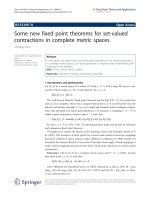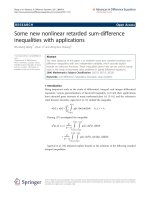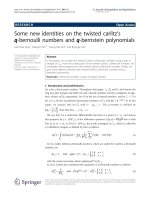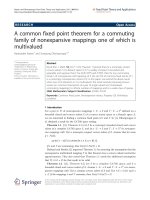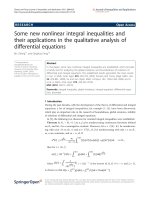Báo cáo hóa học: " Some new fixed point theorems for set-valued contractions in complete metric spaces" doc
Bạn đang xem bản rút gọn của tài liệu. Xem và tải ngay bản đầy đủ của tài liệu tại đây (260.96 KB, 8 trang )
RESEARC H Open Access
Some new fixed point theorems for set-valued
contractions in complete metric spaces
Chi-Ming Chen
Correspondence:
edu.tw
Department of Applied
Mathematics, National Hsinchu
University of Education, Taiwan
Abstract
In this article, we obtain some new fixed point theorems for set-valued contractions
in complete metric spaces. Our results generalize or improve many recent fixed point
theorems in the literature.
MSC: 47H10, 54C60, 54H25, 55M20.
Keywords: fixed point theorem, set-valued contraction
1 Introduction and preliminaries
Let (X, d) be a metric space, D a subset of X and f : D ® X be a map. We say f is con-
tractive if there exists a Î [0, 1) such that for all x, y Î D,
d
(
fx, fy
)
≤ α · d
(
x, y
).
The well-known Banach’s fixed point theorem asserts that if D = X, f is contractive
and (X, d) is complete, then f has a unique fixed point in X. It is well known that the
Banach contraction principle [1] is a very useful and classical tool in nonlinear analysis.
Also, this principle has many generalizations. For instance, a mapping f : X ® X is
called a quasi-contraction if there exists k < 1 such that
d
(
fx, fy
)
≤ k · max{d
(
x, y
)
, d
(
x, fx
)
, d
(
y, fy
)
, d
(
x, fy
)
, d
(
y, fx
)}
for any x, y Î X. In 1974, C’iric’ [2] introduced these maps and proved an existence
and uniqueness fixed point theorem.
Throughout we denote the family of all nonempty closed and bounded subsets of X
by CB(X). The existence of fixed points for various multi-valued contractive mappings
had been studied by many auth ors under different conditions. In 1969, Nadler [3]
extended the famous Banach Contraction Principle from single-valued mapping to
multi-valued mapping and proved the below fixed point theorem for multi-valued
contraction.
Theorem 1 [3]Let (X, d) be a complete metric space and T : X ® CB(X). Assume
that there exists c Î [0, 1) such that
H
(
Tx, Ty
)
≤ cd
(
x, y
)
for all x, y ∈ X
,
where
H
denotes the Hausdo rff metric on CB(X) induced by d, that is, H(A, B)=max
{sup
xÎA
D(x, B), sup
yÎB
D(y, A)}, for all A, B Î CB(X) and D(x , B) = inf
zÎB
d(x, z). Then,
T has a fixed point in X.
Chen Fixed Point Theory and Applications 2011, 2011:72
/>© 2011 Chen; licensee Springer. This is an Open Access article distributed under the terms of the Creative Commons Attribution
License (http://cre ativecommons.org/lice nses/by/2.0), which permits unrestricted use, distribution, and reproduction in a ny mediu m,
provided the original work is properly cited.
In 1989, Mizoguchi-Takahashi [4] proved the following fixed point theorem.
Theorem 2 [4]Let (X, d) be a complete metric space and T : X ® CB(X). Assume
that
H
(
Tx, Ty
)
≤ ξ
(
d
(
x, y
))
· d
(
x, y
)
for all x, y Î X, where ξ :[0,∞) ® [0, 1) satisfies
lim sup
s
→
t
+
ξ(s) <
1
for all t Î [0,
∞). Then, T has a fixed point in X.
In the recent, Amini-Harandi [5] gave th e following fixed point theorem for set-
valued quasi-contraction maps in metric spaces.
Theorem 3 [5]Let (X, d) be a complete metric space. Let T : X ® CB(X) be a k-set-
valued quasi-contraction with
k <
1
2
, that is,
H
(
Tx, Ty
)
≤ k · max{
(
x, y
)
, D
(
x, Tx
)
, D
(
y, Ty
)
, D
(
x, Ty
))
, D
(
y, Tx
)}
for any x, y Î X. Then, T has a fixed point in X.
2 Fixed point theorem (I)
In this section, we assume that the function ψ : ℝ
+5
® ℝ
+
satisfies the following
conditions:
(C1) ψ is a strictly increasing, continuous function in each coordinate, and
(C2) for all t Î ℝ
+
, ψ(t, t, t,0,2t)<t, ψ(t, t, t,2t,0)<t, ψ(0, 0, t, t,0)<t and ψ(t,0,0,
t, t)<t.
Definition 1 Let (X, d) be a metric space. The set-valued map T : X ® Xissaidto
be a set-valued ψ-contraction, if
H
(
Tx, Ty
)
≤ ψ
(
d
(
x, y
)
, D
(
x, Tx
)
, D
(
y, Ty
)
, D
(
x, Ty
))
, D
(
y, Tx
))
for all x, y Î X.
We now st ate the main fixed point theorem for a set-valued ψ-contraction in metric
spaces, as follows:
Theorem 4 Let (X, d) be a complete metric space. Let T : X ® CB(X) be a set-valued
ψ-contraction. Then, T has a fixed point in X.
Proof. Note that for each A, B Î CB(X), a Î A and g >0with
H
(
A, B
)
<
γ
,there
exists b Î B such that d(a, b)<g.SinceT : X ® CB(X)isaset-valuedψ-contraction,
we have
H
(
Tx, Ty
)
≤ ψ
(
d
(
x, y
)
, D
(
x, Tx
)
, D
(
y, Ty
)
, D
(
x, Ty
))
, D
(
y, Tx
))
for all x, y Î X. Suppose that x
0
Î X and that x
1
Î X. Then, by induction and by the
above observation, we can find a sequence {x
n
}inX such that x
n+1
Î Tx
n
and for each
n Î N,
d(x
n+1
, x
n
) ≤ ψ(d(x
n
, x
n−1
), D(x
n
, Tx
n
), D(x
n−1
, Tx
n−1
), D(x
n
, Tx
n−1
), D(x
n−1
, Tx
n
)
)
≤ ψ(d(x
n
, x
n−1
), d(x
n
, x
n+1
), d(x
n−1
, x
n
), d(x
n
, x
n
), d(x
n−1
, x
n+1
))
≤ ψ
(
d
(
x
n
, x
n−1
)
, d
(
x
n
, x
n+1
)
, d
(
x
n−1
, x
n
)
,0,d
(
x
n−1
, x
n
)
+ d
(
x
n
, x
n+1
))
,
and hence, we can deduce that for each n Î N,
d
(
x
n+1
, x
n
)
≤ d
(
x
n
, x
n−1
).
Let we denote c
m
= d(x
m+1
, x
m
). Then, c
m
is a non-increasing sequence and bounded
below. Thus, it must converges to some c ≥ 0. If c > 0, then by the above inequalities,
Chen Fixed Point Theory and Applications 2011, 2011:72
/>Page 2 of 8
we have
c ≤ c
n+1
≤ ψ
(
c
n
, c
n
, c
n
,0,2c
n
).
Passing to the limit, as n ® ∞, we have
c ≤ c ≤ ψ
(
c, c, c,0,2c
)
< c
,
which is a contradiction. Hence, c =0.
We next claim that the following result holds:
for each g > 0, there is n
0
(g) Î N such that for all m >n >n
0
(g),
d
(
x
m
, x
n
)
<γ.
(
∗
)
We shall prove (*) by contradiction. Suppose that (*)is false. Then, there exists some
g > 0 such that for all k Î N, there exist m
k
, n
k
Î N with m
k
>n
k
≥ k satisfying:
(1) m
k
is even and n
k
is odd;
(2)
d(x
m
k
, x
n
k
) ≥
γ
;
(3) m
k
is the smallest even number such that the conditions (1), (2) hold.
Since c
m
↘ 0, by (2), we have
lim
k→∞
d(x
m
k
, x
n
k
)=
γ
and
γ ≤ d(x
m
k
, x
n
k
) ≤ H(Tx
m
k
−1
, Tx
n
k
−1
)
≤ ψ(d(x
m
k
−1
, x
n
k
−1
), d(x
m
k
−1
, x
m
k
), d(x
n
k
−1
, x
n
k
), d(x
m
k
−1
, x
n
k
), d(x
n
k
−1
, x
m
k
))
≤ ψ(c
m
k
−1
+ d(x
m
k
, x
n
k
)+c
n
k
−1
, c
m
k
−1
, c
n
k
−1
, c
m
k
−1
+ d(x
m
k
, x
n
k
), d(x
m
k
, x
n
k
)+c
n
k
−1
))
.
Letting k ® ∞. Then, we get
γ ≤ ψ
(
γ ,0,0,γ , γ
)
<γ
,
a contradictio n. It follows from (*) that the sequence {x
n
} must be a Cauchy
sequence.
Similarly, we also conclude that for each n Î N,
d(x
n
, x
n+1
) ≤ ψ(d(x
n−1
, x
n
), D(x
n−1
, Tx
n−1
), D(x
n
, Tx
n
), D(x
n−1
, Tx
n
), D(x
n
, Tx
n−1
)
)
≤ ψ(d(x
n−1
, x
n
), d(x
n−1
, x
n
), d(x
n
, x
n+1
), d(x
n−1
, x
n+1
), d(x
n
, x
n
))
≤ ψ
(
d
(
x
n−1
, x
n
)
, d
(
x
n
, x
n+1
)
, d
(
x
n−1
, x
n
)
, d
(
x
n−1
, x
n
)
+ d
(
x
n
, x
n+1
)
,0
)
,
and hence, we have that for each n Î N,
d
(
x
n
, x
n+1
)
≤ d
(
x
n−1
, x
n
).
Let we denote b
m
= d( x
m
, x
m+1
). Then, b
m
is a non-increasing sequence and bounded
below. Thus, it must converges to some b ≥ 0. If b > 0, then by the above inequalitie s,
we have
b
≤ b
n+1
≤ ψ
(
b
n
, b
n
, b
n
,2b
n
,0
).
Passing to the limit, as n ® ∞, we have
b
≤ b ≤ ψ
(
b, b, b,2b,0
)
< b
,
which is a contradiction. Hence, b = 0. By the above argument, we also conclude that
{x
n
} is a Cauchy sequence.
Chen Fixed Point Theory and Applications 2011, 2011:72
/>Page 3 of 8
Since X is complete, there exists μ Î X such that lim
n®∞
x
n
= μ. Therefore,
D(μ, Tμ) = lim
n→∞
D(x
n+1
, Tμ)
≤ lim
n→∞
H(Tx
n
, Tμ)
≤ lim
n→∞
ψ(d(x
n
, μ), D(x
n
, Tx
n
), D(μ, Tμ), D(x
n
, Tμ), D(μ, Tx
n
)
)
≤ lim
n→∞
ψ(d(x
n
, μ), d(x
n
, x
n+1
), D(μ, Tμ), D(x
n
, Tμ), d(μ, x
n+1
))
≤ ψ(0, 0, D(μ, Tμ), D(μ, Tμ), 0)
< D
(
μ, Tμ
)
,
and hence, D(μ, Tμ) = 0, that is, μ Î Tμ, since Tμ is closed.
3 Fixed point theorem (II)
In 1972, Chatterjea [6] introduced the following definition.
Definition 2 Let (X, d) be a metric space. A mapping f : X ® X is said to be a
C
-con-
traction if there exists
α
∈ (0,
1
2
)
such that for all x, y Î X, the following inequality
holds:
d
(
fx, fy
)
≤ α ·
(
d
(
x, fy
)
+ d
(
y, fx
)).
Choudhury [7] introduced a generalization of
C
-contraction, as follows:
Definition 3 Let ( X, d) be a metric space. A mapping f : X ® Xissaidtobea
weakly
C
-contraction if for all x, y Î X,
d(fx, fy) ≤
1
2
(d(x, fy)+d(y, fx) − φ(d(x, fy), d(y, fx)))
,
where j : ℝ
+2
® ℝ
+
is a continuous function such that ψ(x, y)=0if and only if x = y =0.
In [6,7], the authors proved some fixed point results for the
C
-contractions. In this
section, we present some fixed point results for t he weakly ψ-
C
-contractionincom-
plete metric spaces.
Definition 4 Let (X, d) be a metric space. The set-valued map T : X ® Xissaidto
be a set-valued weakly ψ-
C
-contraction, if for all x, y Î X
H
(
Tx, Ty
)
≤ ψ
(
[D
(
x, Ty
)
+ D
(
y, Tx
)
− φ
(
D
(
x, Ty
)
, D
(
y, Tx
))
]
),
where
(1) ψ : ℝ
+
® ℝ
+
is a strictly increasing, continuous function with
ψ(t) ≤
1
2
t
for all t >
0 and ψ(0) = 0;
(2) j : ℝ
+2
® ℝ
+
is a strictly decreasing, continuous function in each coordinate, such
that j(x, y)=0if and only if x = y = 0 and j(x, y) ≤ x + y for all x, y Î ℝ
+
.
Theorem 5 Let (X, d) be a complete metric space. Let T : X ® CB(X) be a set-valued
weakly
C
-contraction. Then, T has a fixed point in X.
Proof. Note that for each A, B Î CB(X), a Î A and g >0with
H
(
A, B
)
<
γ
,there
exists b Î B such that d(a, b)<g. Since T : X ® CB(X) be a set-valued weakly ψ-
C
-con-
traction, we have that
H
(
Tx, Ty
)
≤ ψ
(
[D
(
x, Ty
)
+ D
(
y, Tx
)
− φ
(
D
(
x, Ty
)
, D
(
y, Tx
))
]
)
for all x, y Î X. Suppose that x
0
Î X and that x
1
Î X. Then, by induction and by the
above observation, we can find a sequence {x
n
}inX such that x
n+1
Î Tx
n
and for each
Chen Fixed Point Theory and Applications 2011, 2011:72
/>Page 4 of 8
n Î N,
d(x
n+1
, x
n
) ≤
H
(Tx
n
, Tx
n−1
)
≤ ψ([D(x
n
, Tx
n−1
)+D(x
n−1
, Tx
n
) − φ( D(x
n
, Tx
n−1
), D(x
n−1
, Tx
n
))]
)
≤ ψ([d(x
n
, x
n
)+d(x
n−1
, x
n+1
) − φ( d(x
n
, x
n
), d(x
n−1
, x
n+1
))])
= ψ([0 + d(x
n−1
, x
n+1
) − φ(0, d(x
n−1
, x
n+1
))])
≤ ψ([d(x
n−1
, x
n
)+d(x
n
, x
n+1
)])
≤
1
2
[d(x
n−1
, x
n
)+d(x
n
, x
n+1
)],
and hence, we deduce that for each n Î N,
d
(
x
n+1
, x
n
)
≤ d
(
x
n
, x
n−1
).
Thus, {d(x
n+1
, x
n
)} is non-increasing sequence and bounded below and hence it is
convergent. Let lim
n®∞
d(x
n+1
, x
n
)=ξ. Letting n ® ∞ in (**), we have
ξ = lim
n→∞
d(x
n+1
, x
n
) ≤ lim
n→∞
ψ([d(x
n−1
, x
n+1
)])
≤ lim
n→∞
1
2
[d(x
n−1
, x
n+1
)]
≤ lim
n→∞
1
2
[d(x
n−1
, x
n
)+d(x
n
, x
n+1
)
]
≤
1
2
[ξ + ξ]=ξ,
that is,
lim
n
→
∞
d(x
n−1
, x
n+1
)=2ξ
.
By the continuity of ψ and j, letting n ® ∞ in (**), we have
ξ ≤ ψ(2ξ − φ(0, 2ξ )) ≤ ξ −
1
2
· φ(0, 2ξ ) ≤ ξ
.
Hence, we have j(0, 2ξ) = 0, that is, ξ = 0. Thus, lim
n®∞
d(x
n+1
, x
n
)=0.
We next claim that the following result holds:
for each g > 0, there is n
0
(g) Î N such that for all m >n >n
0
(g),
d
(
x
m
, x
n
)
<γ.
(
∗∗∗
)
We shall prove (***) by contradiction. Suppose that (***) is false. Then, there exists
some g > 0 such that for all k Î N, there exist m
k
, n
k
Î N with m
k
>n
k
≥ k satisfying:
(1) m
k
is even and n
k
is odd;
(2)
d(x
m
k
, x
n
k
) ≥
γ
;
(3) m
k
is the smallest even number such that the conditions (1), (2) hold.
Since d(x
n+1
, x
n
) ↘ 0, by (2), we have
lim
k→∞
d(x
m
k
, x
n
k
)=
γ
and
γ ≤ d(x
m
k
, x
n
k
) ≤ H(Tx
m
k
−1
, Tx
n
k
−1
)
≤ ψ([D(x
m
k
−1
, Tx
n
k
−1
)+D(x
n
k
−1
, Tx
m
k
−1
) − φ(D(x
m
k
−1
, Tx
n
k
−1
), D(x
n
k
−1
, Tx
m
k
−1
))]
)
≤ ψ([d(x
m
k
−1
, x
n
k
)+d(x
n
k
−1
, x
m
k
) − φ(d(x
m
k
−1
, x
n
k
), d(x
n
k
−1
, Tx
m
k
))]).
Since
d(x
m
k
−1
, x
n
k
)+d(x
n
k
−1
, x
m
k
) ≤ d(x
m
k
−1
, x
m
k
)+d(x
m
k
, x
n
k
)+d(x
n
k
, x
m
k
)+d(x
n
k
−1
, x
n
k
)
,
Chen Fixed Point Theory and Applications 2011, 2011:72
/>Page 5 of 8
letting k ® ∞, then we get
γ ≤ ψ
(
2γ − φ
(
γ , γ
))
≤ γ
,
and hence, j(g, g)) = 0. By the definition of j,wegetg =0,acontradiction.This
proves that the sequence {x
n
} must be a Cauchy sequence.
Since X is complete, there exists z Î X such that lim
n®∞
x
n
= z. Therefore,
D(z, Tz) = lim
n→∞
D(x
n+1
, Tz)
≤ lim
n→∞
H(Tx
n
, Tz)
≤ lim
n→∞
ψ([D(x
n
, Tz)+D(z, Tx
n
) − φ(D(x
n
, Tz), D(z, Tx
n
))]
)
≤ lim
n→∞
ψ([D(x
n
, Tz)+d(z, x
n+1
) − φ(D(x
n
, Tz), d(z, x
n+1
))])
≤
1
2
D(z, Tz)
and hence, D(z, Tz) = 0, that is, z Î Tz, since Tz is closed.
4 Fixed point theorem (III)
In this section, we recall the notion of the Meir-Keeler type function (see [8]). A func-
tion : ℝ
+
® ℝ
+
is said to be a Meir-Keeler type function, if for each h >0,there
exists δ > 0 such that for t Î ℝ
+
with h ≤ t <h + δ,wehave(t)<h. We now intro-
duce the new notions of the weaker Meir-Keeler type function : ℝ
+
® ℝ
+
in a metric
space and the -function using the weaker Meir-Keeler type function, as follow:
Definition 5 Let (X, d) be a metric space. We call : ℝ
+
® ℝ
+
a weaker Meir-Keeler
type function, if for each h >0,there exists δ >0such that for x, y Î X with h ≤ d(x, y)
<δ + h, there exists n
0
Î N such that
ϕ
n
0
(d(x, y)) <γ
η
.
Definition 6 Let (X, d) be a metric space. A weaker Meir-Keeler type function ; ℝ
+
® ℝ
+
is called a -function, if the following conditions hold:
(
1
) (0) = 0, 0 <(t)<t for all t >0;
(
2
) is a strictly increasing function;
(
3
) for each t Î ℝ
+
,{
n
(t)}
nÎN
is decreasing;
(
4
) for each
t
n
∈ R
+
{0
}
, if lim
n®∞
t
n
= g >0,then lim
n®∞
(t
n
)<g;
(
5
) for each t
n
Î ℝ
+
, if lim
n®∞
t
n
=0,then lim
n®∞
(t
n
)=0.
Definition 7 Let (X, d) be a metric space. The set-valued map T : X ® Xissaidto
be a set-valued weaker Meir-Keeler type -contraction, if
H(Tx, Ty) ≤ ϕ
1
2
[D(x, Ty)+D(y, Tx)]
for all x, y Î X.
We now state the main fixed point theorem for a set-valued weaker Meir-Keeler type
ψ-contraction in metric spaces, as follows:
Theorem 6 Let (X, d) be a complete metric space. Let T : CB(X) be a set-valued
weaker Meir-Keeler type ψ-contraction. Then, T has a fixed point in X.
Proof. Note that for each A, B Î CB(X), a Î A and g >0with
H
(
A, B
)
<
γ
,there
exists b Î B such that d(a, b)<g.SinceT : X ® CB(X)beaset-valuedψ-contraction,
we have that
H(Tx, Ty) ≤ ϕ
1
2
[D(x, Ty)+D(y, Tx)]
Chen Fixed Point Theory and Applications 2011, 2011:72
/>Page 6 of 8
for all x, y Î X. Suppose that x
0
Î X and that x
1
Î X. Then, by induction and by the
above observation, we can find a sequence {x
n
}inX such that x
n+1
Î Tx
n
and for each
n Î N,
d(x
n+1
, x
n
) ≤ ϕ
1
2
[D(x
n
, Tx
n−1
)+D(x
n−1
, Tx
n
)]
≤ ϕ
1
2
[d(x
n
, x
n
)+d(x
n−1
, x
n+1
)]
≤ ϕ
1
2
[d(x
n−1
, x
n
)+d(x
n
, x
n+1
)]
,
and by the conditions (
1
) and (
2
), we can deduce that for each n Î N,
d
(
x
n+1
, x
n
)
≤ ϕ
(
d
(
x
n
, x
n−1
))
< d
(
x
n
, x
n−1
)
and
d
(
x
n+1
, x
n
)
≤ ϕ
(
d
(
x
n
, x
n−1
))
≤···≤ ϕ
n
(
d
(
x
1
, x
0
)).
By the condition (
3
), {
n
(d(x
0
, x
1
))}
nÎN
is decreasing, it must converges to some h ≥
0. We claim that h = 0. On the contrary, assume that h > 0. Then, by the definition of
the weaker Meir-Keeler type function, there exists δ > 0 such that for x
0
, x
1
Î X with
h ≤ d (x
0
, x
1
)<δ + h,thereexistsn
0
Î N such that
ϕ
n
0
(
d
(
x
0
, x
1
))
<
η
. Since lim
n®∞
n
(d(x
0
, x
1
)) = h, there exists m
0
Î N such that h ≤
m
(d(x
0
, x
1
)) <δ + h, for all m ≥ m
0
.
Thus, we c onclude that
ϕ
m
0
+n
0
(
d
(
x
0
, x
1
))
<
η
. Hence, we get a contradiction. Hence,
lim
n®∞
n
(d(x
0
, x
1
)) = 0, and hence, lim
n®∞
d(x
n
, x
n+1
)=0.
Next, we let c
m
= d(x
m
, x
m+1
), and we claim that the following result holds:
for each ε > 0, there is n
0
(ε) Î N such that for all m , n ≥ n
0
(ε),
d
(
x
m
, x
m+1
)
<ε.
(
∗∗∗∗
)
We shall prove (****) by contradiction. Suppose that (****) is false. Then, there exists
some ε > 0 such that for all p Î N, there are m
p
, n
p
Î N with m
p
>n
p
≥ p satisfying:
(i) m
p
is even and n
p
is odd,
(ii)
d(x
m
p
, x
n
p
) ≥
ε
, and
(iii) m
p
is the smallest even number such that the conditions (i), (ii) hold.
Since c
m
↘ 0, by (ii), we have
lim
p→∞
d(x
m
p
, x
n
p
)=
ε
, and
ε ≤ d(x
m
p
, x
n
p
)
≤
H(Tx
m
p
−1
, Tx
n
p
−1
)
≤ ϕ
1
2
[D(x
m
p
−1
, Tx
n
p
−1
)+D(x
n
p
−1
, Tx
m
p
−1
)]
≤ ϕ
1
2
[d(x
m
p
−1
, x
n
p
)+d(x
n
p
−1
, x
m
p
)]
≤ ϕ
1
2
[d(x
m
p
−1
, x
m
p
)+2d(x
n
p
, x
m
p
)+d(x
n
p
−1
, x
n
p
)]
.
Chen Fixed Point Theory and Applications 2011, 2011:72
/>Page 7 of 8
Letting p ® ∞. By the condition (
4
), we have
ε ≤ lim
p→∞
ϕ
1
2
[d(x
m
p
−1
, x
m
p
)+2d(x
n
p
, x
m
p
)+d(x
n
p
−1
, x
n
p
)]
<ε
,
a contradiction. Hence, {x
n
} is a Cauchy sequence. Since (X, d) is a complete metric
space, there exists μ Î X such that limn®∞x
n+1
= μ. Therefore,
D(μ, Tμ) = lim
n→∞
D(x
n+1
, Tμ)
≤ lim
n→∞
H(Tx
n
, Tμ)
≤ lim
n→∞
ϕ
1
2
[D(x
n
, Tμ)) + D(μ, Tx
n
)
≤ lim
n→∞
ϕ
1
2
[D(x
n
, Tμ)) + d(μ, x
n+1
)
≤
1
2
D(μ, Tμ),
and hence, D(μ, Tμ) = 0, that is, μ Î Tμ, since Tμ is closed.
Acknowledgements
This research was supported by the National Science Council of the Republic of China.
Competing interests
The author declares he has no competing interests
Received: 27 July 2011 Accepted: 31 October 2011 Published: 31 October 2011
References
1. Banach, S: Sur les operations dans les ensembles abstraits et leur application aux equations integerales. Fund Math. 3,
133–181 (1922)
2. C’iric’, LB: A generalization of Banach’s contraction principle. Proc Am Math Soc. 45(2), 45–181 (1974)
3. Nadler, SB Jr: Multi-valued contraction mappings. Pacific J Math. 30, 475–488 (1969)
4. Mizoguchi, N, Takahashi, W: Fixed point theorems for multi-valued mappings on complete metric spaces. J Math Anal
Appl. 141, 177–188 (1989). doi:10.1016/0022-247X(89)90214-X
5. Amini-Harandi, A: Fixed point theory for set-valued quasi-contraction maps in metric spaces. Appl Math Lett. 24(2),
24–1794 (2011)
6. Chatterjea, SK: Fixed point theorems. C.R Acad Bulgare Sci. 25, 727–730 (1972)
7. Choudhury, BS: Unique fixed point theorem for weakly
C
-contractive mappings. Kathmandu Uni J Sci Eng Technol.
5(2), 5–13 (2009)
8. Meir, A, Keeler, E: A theorem on contraction mappings. J Math Anal Appl. 28, 326–329 (1969). doi:10.1016/0022-247X
(69)90031-6
doi:10.1186/1687-1812-2011-72
Cite this article as: Chen: Some new fixed point theorems for set-valued contractions in complete metric spaces.
Fixed Point Theory and Applications 2011 2011:72.
Submit your manuscript to a
journal and benefi t from:
7 Convenient online submission
7 Rigorous peer review
7 Immediate publication on acceptance
7 Open access: articles freely available online
7 High visibility within the fi eld
7 Retaining the copyright to your article
Submit your next manuscript at 7 springeropen.com
Chen Fixed Point Theory and Applications 2011, 2011:72
/>Page 8 of 8





